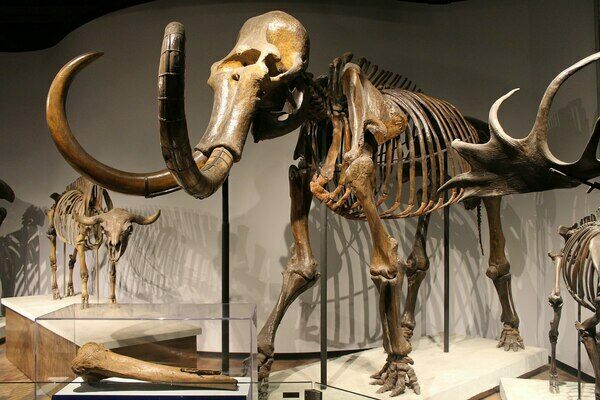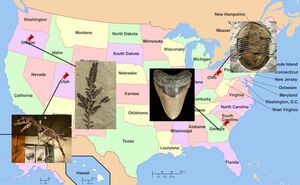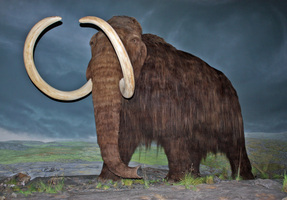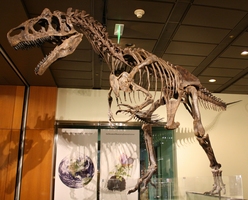Vermont State Fossil - Mount Holly Mammoth & Charlotte Whale
In 1993, the Vermont state legislature designated the fossil, beluga whale skeleton housed at the Perkins Geology Museum as the Vermont state fossil. In 2014 this designation was amended, making the beluga whale skeleton the state marine fossil while declaring the Mount Holly Mammoth the state terrestrial fossil. Vermont is the only state that designates a living species as their state fossil.
The beluga whale (Delphinapterus leucas) skeleton was unearthed near Charlotte, Vermont in 1849. It was found in blue clay ten feet below the surface during the construction of a railroad. Because Charlotte is over 150 miles from the nearest ocean, early naturalists were at a loss to explain the bones of a marine whale buried beneath the fields of rural Vermont.
The skeleton dates back to around 12,500 years ago when an arm of the Atlantic Ocean known as the Champlain Sea covered parts of Vermont and New York. The tremendous weight of one mile thicks glaciers during the ice age had depressed the land in this area of Vermont. As the glaciers retreated at the end of the ice age, this area was left below sea level and the Atlantic ocean flooded in for approximately 2,500 years.
Discovered in 1848, the Mount Holly Mammoth consists of a fossil molar, two tusks and several bones which were found in a peat bog on Mt. Holly during construction of a railroad.
"In making this excavation, the workmen found at the bottom of the bed, resting upon gravel which separated it from the rock below, a huge tooth. The depth of the peat at that place was eleven feet. Soon afterwards one of the tusks was found, about eighty feet from the place of the tooth mentioned above, which was a grinder. Subsequently the other tusk and several of the bones of the animal were found near the same place. These bones and teeth were submitted to the inspection of Professor Agassiz, who pronounced them to be extinct species of elephant. The directors of the R.& B.R.R. to whom they belong, placed them in the museum of the University of Vermont, for preservation, and for the illustration of our fossil geology.”
The Mount Holly Mammoth is a woolly mammoth (Mammuthus primigenius). The woolly mammoth was roughly the same size as modern African elephants, reaching heights of about 11 feet tall and weighing up to 6 tons. The woolly mammoth was well adapted to the cold environment during the last ice age. It was covered in fur, with an outer covering of long guard hairs and a shorter undercoat.
Woolly Mammoths are believed to have descended from the Steppe Mammoth about 400,000 years ago in Eastern Asia before crossing a land bridge into Alaska about 100,000 years ago. From there they migrated south, inhabiting much of North America during the ice age. The last of the woolly mammoths went extinct as recently as 3,600 years ago.
The Charlotte Whale
The beluga whale (Delphinapterus leucas) skeleton was unearthed near Charlotte, Vermont in 1849. It was found in blue clay ten feet below the surface during the construction of a railroad. Because Charlotte is over 150 miles from the nearest ocean, early naturalists were at a loss to explain the bones of a marine whale buried beneath the fields of rural Vermont.
The skeleton dates back to around 12,500 years ago when an arm of the Atlantic Ocean known as the Champlain Sea covered parts of Vermont and New York. The tremendous weight of one mile thicks glaciers during the ice age had depressed the land in this area of Vermont. As the glaciers retreated at the end of the ice age, this area was left below sea level and the Atlantic ocean flooded in for approximately 2,500 years.
The Mount Holly Mammoth
Discovered in 1848, the Mount Holly Mammoth consists of a fossil molar, two tusks and several bones which were found in a peat bog on Mt. Holly during construction of a railroad.
"In making this excavation, the workmen found at the bottom of the bed, resting upon gravel which separated it from the rock below, a huge tooth. The depth of the peat at that place was eleven feet. Soon afterwards one of the tusks was found, about eighty feet from the place of the tooth mentioned above, which was a grinder. Subsequently the other tusk and several of the bones of the animal were found near the same place. These bones and teeth were submitted to the inspection of Professor Agassiz, who pronounced them to be extinct species of elephant. The directors of the R.& B.R.R. to whom they belong, placed them in the museum of the University of Vermont, for preservation, and for the illustration of our fossil geology.”
The Mount Holly Mammoth is a woolly mammoth (Mammuthus primigenius). The woolly mammoth was roughly the same size as modern African elephants, reaching heights of about 11 feet tall and weighing up to 6 tons. The woolly mammoth was well adapted to the cold environment during the last ice age. It was covered in fur, with an outer covering of long guard hairs and a shorter undercoat.
Woolly Mammoths are believed to have descended from the Steppe Mammoth about 400,000 years ago in Eastern Asia before crossing a land bridge into Alaska about 100,000 years ago. From there they migrated south, inhabiting much of North America during the ice age. The last of the woolly mammoths went extinct as recently as 3,600 years ago.
 Reviews
Reviews







